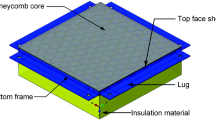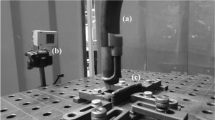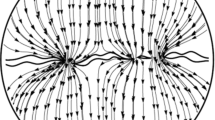Abstract
Precise knowledge of thermal contact conductance (TCC) across fixed solid contacts of flat-flat and curvilinear surfaces is becoming a crucial topic in advanced industrial applications such as thermal management of electronic packaging and nuclear energy production. In this study, at first, TCC across fixed solid contacts of flat-flat and cylinder-cylinder contacts has been calculated by inverse solution method. Furthermore, the accuracy of inverse method for estimation of TCC between flat-flat and cylinder-cylinder contacts has been evaluated based on the error analysis. Then, the GMDH (group method of data handling) algorithm has been used for heat transfer function estimation between contact surfaces based on input–output data which has been achieved from the experimental investigation and the inverse method using the Conjugate Gradient Method (CGM) with Adjoint problem. Different models of GMDH algorithm are applied and the optimal model is selected based on the common error criteria of RMSE (root mean square error). According to the results, the inverse method is accurate enough to predict TCC between flat-flat and cylinder-cylinder contacts with the root mean square error of 0.167 and 0.205, respectively. Also, it has shown that among the different models of GMDH algorithm, Genetic algorithm obtained by SVD method, make the best algorithm for TTC identification in fixed flat-flat and cylinder-cylinder contacting surfaces. Meanwhile, the attained Root Mean Square Error (RMSE) of the Genetic algorithm obtained by SVD method compared with the experimental results for flat-flat and cylinder-cylinder are 0.1459 and 0.1758, respectively.
















Similar content being viewed by others
Abbreviations
- CGM :
-
Conjugate gradient method
- h c :
-
Thermal contact conductance
- k :
-
Thermal conductivity
- q :
-
Heat flux
- T :
-
Temperature
- R :
-
Result function
- x :
-
Cartesian spatial coordinate
- RMSE :
-
Root mean square error
- L :
-
Length
- t :
-
Time
- Y :
-
Measured temperatures
- T 0 :
-
Constant temperature at x = 0 (K)
- T i :
-
Initial temperature (K)
- α :
-
Thermal diffusivity
- β :
-
Search step size
- γ :
-
Conjugation coefficient
- λ :
-
Lagrange multiplier satisfying the Adjoint problem
References
Minges ML (1966) Thermal contact resistance, vol. 1, A Review of the Literature, Technical Report AFML-TR-65-375, Wright-Patterson Air Force Base, Dayton, Ohio, USA
Moore CJ (1967) Heat transfer across surfaces, Ph.D. Dissertation, Southern Methodist University, Dallas, Texas, USA
Moore CJ, H. Atkins, and H. A. Blum, (1968) Subject Classification Bibliography for Thermal Contact Resistance Studies, ASME Paper No. 68-WA/HT-18
Zhu Z, Zhang L, Zhang C, Li R, Gu S (2016) Experimental investigation of transient contact heat transfer between 300M and 5CrNiMo. Int J Heat Mass Transf 96:451–457
Tariq A, Asif M (2016) Experimental investigation of thermal contact conductance for nominally flat metallic contact. Heat Mass Transf 52:291–307
Ding C, Wang R (2012) Thermal contact conductance of stainless steel-GFRP interface under vacuum environment. Exp Thermal Fluid Sci 42:1–5
Sponagle B, Groulx D (2016) Measurement of thermal interface conductance at variable clamping pressures using a steady state method. Appl Therm Eng 96:671–681
Rosochowska M (2002) Measurements of thermal contact conductance. J Mater Process Technol 135:204–210
Misra P, Nagaraju J (2010) An experimental study to show the effect of thermal stress on thermal contact conductance at sub-megapascal contact pressures. J Heat Transf 132(9):94501
Zhu Z, Zhang LW, Wu QK, Gu SD (2013) An experimental investigation of thermal contact conductance of Hastelloy C-276 based on steady-state heat flux method. Int Commun Heat Mass Transfer 41:63–67
Dongmei B, Huanxin C, Ye T (2012) Influences of temperature and contact pressure on thermal contact resistance at interfaces at cryogenic temperatures. Cryogenics 52:403–409. https://doi.org/10.1016/j.cryogenics.2012.03.006
Sunil Kumar S, Abilash P.M., Ramamurthi K (2004) Thermal contact conductance for cylindrical and spherical contacts. Heat Mass Transf 40(9):679–688. https://doi.org/10.1007/s00231-003-0433-0
Kumar S, Tariq A (2017) Steady state experimental investigation of thermal contact conductance between curvilinear contacts using liquid crystal thermography. Int J Therm Sci 118:53–68
McGee GR, Schankula MH, Yovanovich MM (1985) Thermal resistance of cylinder-flat contacts: Theoretical analysis and experimental verification of a line-contact model. Nucl Eng Des 86(3):369–381
Asif M, Tariq A (2016) Correlations of thermal contact conductance for nominally flat metallic contact in vacuum. Experimental Heat Transfer, A Journal of Thermal Energy Generation, Transport, Storage, and Conversion 29(4):1–29
Majid Bahrami, (2004) Modeling of thermal joint resistance for sphere-flat contacts in a vacuum, A thesis presented to the University of Waterloo in fulfillment of the thesis requirement for the degree of Doctor of Philosophy
Astrom KJ, Eykhoff P (1971) System Identification, A survey, Automatica 7:123-126
Shojaeefard MH, Ghaffarpour M, Noorpoor AR (2008) Thermal Contact Analysis Using Identification Method. Heat Transfer Eng 29(1):85–96
Goudarzi K, Moosaei A, Gharaati M (2015) Applying artificial neural networks (ANN) to the estimation of thermal contact conductance in the exhaust valve of internal combustion engine. Appl Therm Eng 87:688–697
Kristinson K, Dumont G (1992) System identification and control using genetic algorithms. IEEE Trans Sys Man Cybern 22(5):1033–1046
Koza J (1992) Genetic programming, on the programming of computers by means of natural selection. MIT Press, Cambridge
Iba H, Kuita T, Degaris H, Sator T, (1993) System identification using structured genetic algorithms, Proc. Of 5 th Int. Conf. On Genetic Algorithms, ICGA’93, USA
Porter B, Nariman-Zadeh N (1994) Genetic design of computed-torque controllers for robotic manipulators, IASTED Int. Conf. on Sys. And Cont., Switzerland
Kumar S, Tariq A (2017) Determination of thermal contact conductance of flat and curvilinear contacts by transient approach. Exp Thermal Fluid Sci 88:261–276
Ozisik MN, Orlande HRB (2000) Inverse heat transfer: fundamentals and applications, 1st edn. CRC Press, Taylor & Francis Group, New York, 352 pages
Alifanov OM (1994) Inverse heat transfer problems. Springer-Verlag, Berlin, 348 p
Beck JV, Blackwell B, Clair CRS (1985) Inverse heat conduction: ill posed problems. Wiley, New York, 308 p
Kartalopoulos SV (2000) Understanding neural networks and fuzzy logic-basic concepts and applications. Prentice Hall, New-Delhi
Kondo T, Ueno J (2008) Multi-layered GMDH-type neural network self-selecting optimum neural network architecture and its application to 3-dimensional medical image recognition of blood vessels. Int J Innov Comput Inf Control 4(1):175–187
Kondo T, Ueno J (2007) Logistic GMDH-type neural network and its application to identification of X-ray film characteristic curve. Journal of Advanced Computational Intelligence and Intelligent Informatics 11(3):312–318
Kondo T (1998) GMDH neural network algorithm using the heuristic self-organization method and its application to the pattern identification problem, Proc. of the 37th SICE Annual Conference, pp.1143-1148
Farlow SJ (1984) Self-organizing methods in modeling, GMDH-type algorithm. Marcel Dekker Inc., New York
Ivakhnenko AG (1970) Heuristic self-organization in problems of engineering cybernetics. Automatica 6(2):207–219
Kondo T, Pandya AS, Zurada JM (1999) GMDH-type neural networks with a feedback loop and their application to nonlinear system identification, Smart Engineering System: Neural Networks, Fuzzy Logic, Evolutionary Programing, Data Mining, and Rough Sets, ASME Press, 9, pp.117–124
Dolenko SA, Orlov YV, Persiantsev IG, (1996) Practical implementation and use of group method of data handling (GMDH): prospects and problems, Proceedings of the ACEDC’96, University of Plymouth, UK
Ivakhnenko AG (1971) Polynomial theory of complex systems. IEEE Trans Syst Man Cybern SMC-1:364–378
Nariman-zadeh N, Darvizeh A, Darvizeh M, Gharababaei H (2002) Modelling of explosive cutting process of plates using GMDH-type neural network and singular value decomposition. J Mater Process Technol 128:80–87
Ahmadi MH, Ahmadi MA, Mehrpooya M, Rosen MA (2015) Using GMDH Neural Networks to Model the Power and Torque of a Stirling Engine. Sustainability 7:2243–2255. https://doi.org/10.3390/su7022243
Bagheri A, Nariman-Zadeh N, Siavash AS, Khoobkar AR (2005) GMDH type neural networks and their application to the identification of the inverse kinematic equations of robotic manipulators. Int J Eng 18(2):135–143
Lawrence PJA, Fogel J, Baeck T (1996) Proceedings of the fifth annual conference on evolutionary programming. evolutionary programming V. MIT Press, Cambridge, pp 461–467
Iba H, deGaris H, Sato T (1996) A numerical approach to genetic programming for system identification. Evol Comput 3(4):417–452
Sanchez G, Frausto-Solis A, Ojeda-Bustamante J (2014) Attribute Selection Impact on Linear and Nonlinear Regression Models for Crop Yield Prediction. Sci World J. https://doi.org/10.1155/2014/509429
Elçiçek H, Akdoğan E, Karagöz S (2014) The Use of Artificial Neural Network for Prediction of Dissolution Kinetics. Sci World J. https://doi.org/10.1155/2014/194874
Author information
Authors and Affiliations
Corresponding author
Ethics declarations
Conflict of interest
The authors declare that they have no conflict of interest.
Additional information
Publisher’s note
Springer Nature remains neutral with regard to jurisdictional claims in published maps and institutional affiliations.
Rights and permissions
About this article
Cite this article
Fathi, S., Eftekhari Yazdi, M. & Adamian, A. Estimation of contact heat transfer between curvilinear contacts using inverse method and group method of data handling (GMDH)-type neural networks. Heat Mass Transfer 56, 1961–1970 (2020). https://doi.org/10.1007/s00231-020-02832-x
Received:
Accepted:
Published:
Issue Date:
DOI: https://doi.org/10.1007/s00231-020-02832-x




